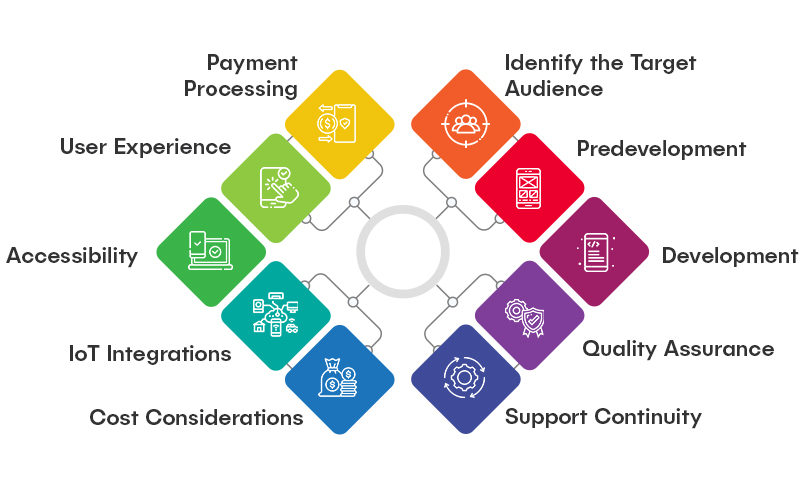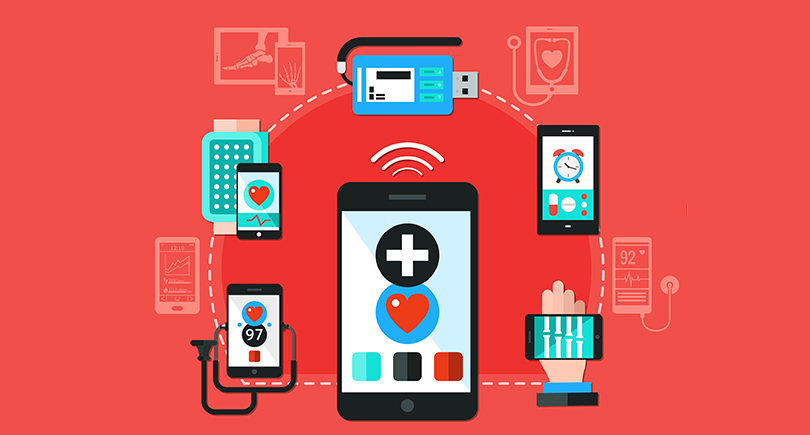As the healthcare industry looks to lap up the benefits of applications of IoT in healthcare applications, medical apps with IoT are increasing in their strength and potential. Enhanced operations, improvements in processes, higher care outcomes, and decreased costs are significant advantages of an IoT platform for healthcare.
With the new normal of COVID-19 and patient safety as a high priority, tailor-made medical apps with IoT have witnessed unprecedented demand. Despite this, developing and incorporating IoT technology for healthcare comes with a set of challenges. As developers look to begin their journey of IoT in healthcare applications, Follow our guide to ensure a successful and seamless journey toward efficient development.
10 Steps for a Successful Medical IoT Platform

1. Identify the Target Audience
We cannot stress the importance of this step enough. IoT healthcare solutions development must be backed by a substantial amount of research that involves knowledge on the client and the target audience, i.e., the users of the app. For example, IoT-based hospital management systems may require practice management solutions or mHealth options. This need cannot be thoroughly identified until the end-users problems are clearly understood. Consistent knowledge of user expectations and feedback will strengthen the process and outcome of IoT-based hospital management systems. Finding the niche of your IoT platform for healthcare is half the development battle.
2. Predevelopment
Once the target audience has been clearly identified and their needs fully understood, the next step in medical apps with IoT would be to initiate the project officially. It is now time to thoroughly study the requirements and specifications that will go into the app, along with which IoT technology for healthcare should be used. For example, you might need to incorporate clinical data analysis and healthcare provider solutions with IoT-based hospital systems. The functionalities of these technologies need to be carefully considered and tailored to fit the client’s requirements through an IoT-based hospital system. The costs and resources involved with the Internet of Things devices should also be accounted for during this stage. The feasibility of the Internet of Things applications should be well thought out.
3. Development
Once your pre-development proof of concept is established, it is time to get going on full-fledged development work. Internet of Things technology for medical purposes requires specific tools and strategies toward development. Determine which programming languages work best for your IoT integrated healthcare system. If your client is looking for custom healthcare solutions, it might be wise to incorporate integrated healthcare systems and healthcare interoperability within the IoT medical devices and software development. Continual testing, through every stage of development, is essential toward mitigating errors through IoT healthcare software development services.
4. Quality Assurance
IoT in healthcare applications, despite continual testing, requires strict adherence to quality assurance testing. This process brings to light any blind spots that may have been missed and increase the chances of IoT applications’ maximum utility in healthcare. For example, IoT devices in healthcare that deal with electronic data exchange and electronic health records should ensure HIPAA compliance and other data security protocol. Seamless IoT applications in healthcare have been developed with stringent quality assurance procedures; they are user-centric and intuitive and conform with established security and safety standards.
5. Support Continuity
After the development is complete, IoT devices in healthcare require continual support. Many clients choose to take on the management of Internet of Things devices. However, the developer must extend full support toward stability. Cloud computing in healthcare can be applied toward maintaining quality compliance. Furthermore, if IoT healthcare software solutions deal with medical records, medical records management solutions can be used for continual support. The Internet of Things technology for medical use may require modifications along the way, and development support for the same is crucial.
6. Cost Considerations
IoT healthcare software development services cannot conform to a fixed cost model since every development version has its approach and estimate. IoT applications in healthcare, for example, that deal with integrated care management and patient engagement solutions, may have a higher costing than other basic apps. Based on the appropriate deployment of IoT in the healthcare market, a cost estimate should be created and provided to the client right at the beginning stage of development. This will avoid developmental delays that may occur with new and surprising costs along the way.
7. IoT Integrations
Integrating IoT device management platforms into established software systems can considerably advance medical software. This integration can range across wearable devices and regular medical devices. With IoT in the healthcare industry, healthcare automation and healthcare analytics solutions can be considerably enhanced. Further, specific IoT technology for healthcare allows the transmission of data from medical devices, through secure clouds and platforms, for analysis and actionable data. One popular example of such a health IoT development is population health management. Such IoT in healthcare applications forms the crux of providing data to improve the overall standards of caregiving and patient experiences.
8. Accessibility
IoT in healthcare applications should be deployed with the priority of a high user experience. Users will easily accept an easy-to-use IoT health monitoring system due to its seamless experience. Intuitive designing and integrated care management are techniques for increasing accessibility in custom app development for IoT and healthcare. Accessibility can be further enhanced through the conscious use of the latest technologies in IoT provider solutions. The app must allow access to users on mobiles, laptops, desktops, etc. Another essential factor would be to enable connectivity for information sharing seamlessly through chats and other messaging features. Telehealth apps require impeccable connectivity options, for example, between the health professional and patients.
9. User Experience
A good user experience is defined by an intuitive dashboard that offers a convenient overview of user-health records for quick accessibility. With an IoT hospital mobile app development, every user can view a customized dashboard with relevant data. A dashboard provides a critical summary of all the information that the user would need from the get-go. These could be health metrics, diet charts, activity tracking summaries, or other relevant information based on healthcare application development.
10. Payment Processing
Another critical factor towards IoT security in healthcare is a secure payment processing methodology that maintains data privacy. Healthcare IoT system management should incorporate payment protocols to offer end-to-end solutions to the users. IoT system management should offer payment convenience options that benefit the patients and providers alike. A health app that manages ease of payment is more likely to succeed due to the mounting financial challenges faced by the healthcare industry.
Conclusion
As IoT system management broadens its horizons across multiple avenues of healthcare applications, the benefits of this technology are plain to see. Digital-savvy consumers, be it patients or providers, are looking to lap up the advantages of these advanced software technologies, and developers are consistently gearing up to match the demand.
However, as healthcare organizations look to empower their businesses with IoT, it would be prudent to opt for services customized to their particular need and in tune with the most updated features and technologies. As new trends and functionalities emerge, a futuristic health app will answer a higher patient/ provider experience.
OSP is a trusted software development company that delivers bespoke solutions as per your business needs. Connect with us to hire the best talents in the industry to build enterprise-grade software.

How can we help?
Fill out the short form below or call us at (888) 846-5382
Looking for software solutions to build your product?
Let's discuss your software solutions for your product in our free development acceleration call!
Get In Touch arrow_forwardDiscuss Your Project Handover with a team of expert Book a free consultation arrow_forward
About Author

Written by Riken Shah linkedin
Riken's work motto is to help healthcare providers use technological advancements to make healthcare easily accessible to all stakeholders, from providers to patients. Under his leadership and guidance, OSP Labs has successfully developed over 600 customized software solutions for 200+ healthcare clients across continents.

















